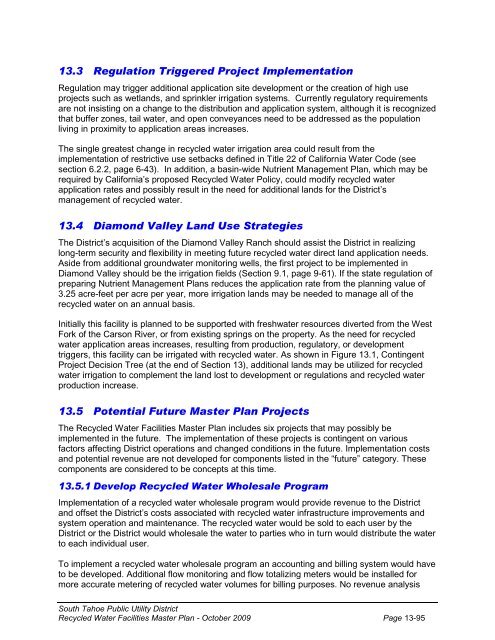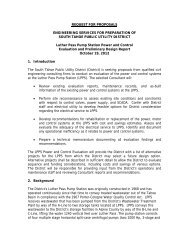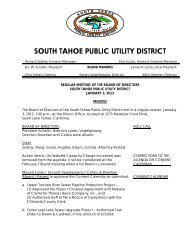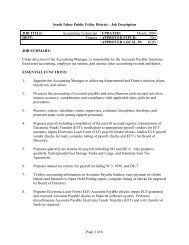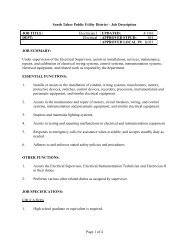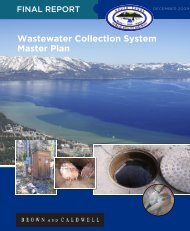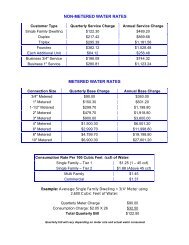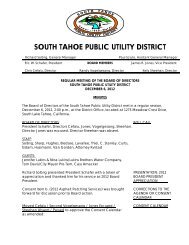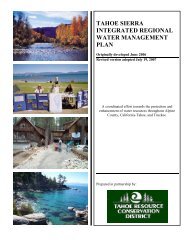October 2009 - South Tahoe Public Utility District
October 2009 - South Tahoe Public Utility District
October 2009 - South Tahoe Public Utility District
You also want an ePaper? Increase the reach of your titles
YUMPU automatically turns print PDFs into web optimized ePapers that Google loves.
13.3 Regulation Triggered Project Implementation<br />
Regulation may trigger additional application site development or the creation of high use<br />
projects such as wetlands, and sprinkler irrigation systems. Currently regulatory requirements<br />
are not insisting on a change to the distribution and application system, although it is recognized<br />
that buffer zones, tail water, and open conveyances need to be addressed as the population<br />
living in proximity to application areas increases.<br />
The single greatest change in recycled water irrigation area could result from the<br />
implementation of restrictive use setbacks defined in Title 22 of California Water Code (see<br />
section 6.2.2, page 6-43). In addition, a basin-wide Nutrient Management Plan, which may be<br />
required by California‟s proposed Recycled Water Policy, could modify recycled water<br />
application rates and possibly result in the need for additional lands for the <strong>District</strong>‟s<br />
management of recycled water.<br />
13.4 Diamond Valley Land Use Strategies<br />
The <strong>District</strong>‟s acquisition of the Diamond Valley Ranch should assist the <strong>District</strong> in realizing<br />
long-term security and flexibility in meeting future recycled water direct land application needs.<br />
Aside from additional groundwater monitoring wells, the first project to be implemented in<br />
Diamond Valley should be the irrigation fields (Section 9.1, page 9-61). If the state regulation of<br />
preparing Nutrient Management Plans reduces the application rate from the planning value of<br />
3.25 acre-feet per acre per year, more irrigation lands may be needed to manage all of the<br />
recycled water on an annual basis.<br />
Initially this facility is planned to be supported with freshwater resources diverted from the West<br />
Fork of the Carson River, or from existing springs on the property. As the need for recycled<br />
water application areas increases, resulting from production, regulatory, or development<br />
triggers, this facility can be irrigated with recycled water. As shown in Figure 13.1, Contingent<br />
Project Decision Tree (at the end of Section 13), additional lands may be utilized for recycled<br />
water irrigation to complement the land lost to development or regulations and recycled water<br />
production increase.<br />
13.5 Potential Future Master Plan Projects<br />
The Recycled Water Facilities Master Plan includes six projects that may possibly be<br />
implemented in the future. The implementation of these projects is contingent on various<br />
factors affecting <strong>District</strong> operations and changed conditions in the future. Implementation costs<br />
and potential revenue are not developed for components listed in the “future” category. These<br />
components are considered to be concepts at this time.<br />
13.5.1 Develop Recycled Water Wholesale Program<br />
Implementation of a recycled water wholesale program would provide revenue to the <strong>District</strong><br />
and offset the <strong>District</strong>‟s costs associated with recycled water infrastructure improvements and<br />
system operation and maintenance. The recycled water would be sold to each user by the<br />
<strong>District</strong> or the <strong>District</strong> would wholesale the water to parties who in turn would distribute the water<br />
to each individual user.<br />
To implement a recycled water wholesale program an accounting and billing system would have<br />
to be developed. Additional flow monitoring and flow totalizing meters would be installed for<br />
more accurate metering of recycled water volumes for billing purposes. No revenue analysis<br />
<strong>South</strong> <strong>Tahoe</strong> <strong>Public</strong> <strong>Utility</strong> <strong>District</strong><br />
Recycled Water Facilities Master Plan - <strong>October</strong> <strong>2009</strong> Page 13-95


